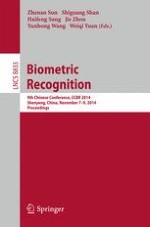2014 | Book
Biometric Recognition
9th Chinese Conference, CCBR 2014, Shenyang, China, November 7-9, 2014. Proceedings
Editors: Zhenan Sun, Shiguang Shan, Haifeng Sang, Jie Zhou, Yunhong Wang, Weiqi Yuan
Publisher: Springer International Publishing
Book Series : Lecture Notes in Computer Science
